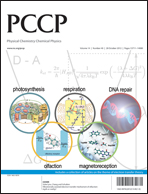Formation of a transient [myoglobin (Mb), cytochrome b5 (cyt b5)] complex is required for the reductive repair of inactive ferri-Mb to its functional ferro-Mb state. The [Mb, cyt b5] complex exhibits dynamic docking (DD), with its cyt b5 partner in rapid exchange at multiple sites on the Mb surface. A triple mutant (Mb(3M)) was designed as part of efforts to shift the electron-transfer process to the simple docking (SD) regime, in which reactive binding occurs at a restricted, reactive region on the Mb surface that dominates the docked ensemble. An electrostatically-guided Brownian dynamics (BD) docking protocol was used to generate an initial ensemble of reactive configurations of the complex between unrelaxed partners. This ensemble samples a broad and diverse array of heme–heme distances and orientations. These configurations seeded all-atom constrained molecular dynamics simulations (MD) to generate relaxed complexes for the calculation of electron tunneling matrix elements (TDA) through tunneling-pathway analysis. This procedure for generating an ensemble of relaxed complexes combines the ability of BD calculations to sample the large variety of available conformations and interprotein distances, with the ability of MD to generate the atomic level information, especially regarding the structure of water molecules at the protein–protein interface, that defines electron-tunneling pathways. We used the calculated TDA values to compute ET rates for the [Mb(wt), cyt b5] complex and for the complex with a mutant that has a binding free energy strengthened by three D/E → K charge-reversal mutations, [Mb(3M), cyt b5]. The calculated rate constants are in agreement with the measured values, and the mutant complex ensemble has many more geometries with higher TDA values than does the wild-type Mb complex. Interestingly, water plays a double role in this electron-transfer system, lowering the tunneling barrier as well as inducing protein interface remodeling that screens the repulsion between the negatively-charged propionates of the two hemes.
![Graphical abstract: Interfacial hydration, dynamics and electron transfer: multi-scale ET modeling of the transient [myoglobin, cytochrome b5] complex](/en/Image/Get?imageInfo.ImageType=GA&imageInfo.ImageIdentifier.ManuscriptID=C2CP41949A&imageInfo.ImageIdentifier.Year=2012)
You have access to this article
 Please wait while we load your content...
Something went wrong. Try again?
Please wait while we load your content...
Something went wrong. Try again?
![Graphical abstract: Interfacial hydration, dynamics and electron transfer: multi-scale ET modeling of the transient [myoglobin, cytochrome b5] complex](/en/Image/Get?imageInfo.ImageType=GA&imageInfo.ImageIdentifier.ManuscriptID=C2CP41949A&imageInfo.ImageIdentifier.Year=2012)

 Please wait while we load your content...
Please wait while we load your content...